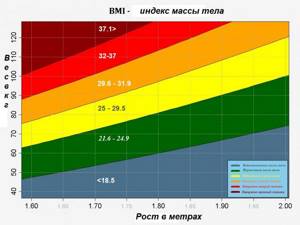Body mass index (BMI), in the English version BMI (Body Mass Index) is a good and simple indicator for assessing weight in adults. It determines the health risks associated with excess or insufficient kilograms. To calculate it, the easiest way is to use an online body mass index calculator .
Please note that BMI is purely indicative.
The most common case where BMI should not be used is when measuring athletes. In such people, muscle tissue is much more developed, and muscles are heavier than fat tissue. A BMI higher than normal does not mean overweight in this case.
This method is not suitable for determining normal weight in pregnant women, as well as for children under the age of 14 years. For children, it is not BMI that is used, but percentile grids.
How to use the Body Mass Index Calculator
The BMI calculator allows you to quickly determine whether your weight is normal or if there are deviations. To do this, just set only three parameters: gender, height, weight, and click on the “Calculate” button.
The calculator will calculate the index by dividing body weight (in kilograms) by height squared (in meters) and display the result.
BMI= body weight/height²
In it, in addition to the index value itself, you will see your diagnosis. The index scale was developed according to WHO standards.
For example, a person who is 173 cm tall and weighs 58 kg would have a BMI of 19.4, which is a normal weight.

Bioimpedancemetry
Bioimpedance sends a small, harmless electrical current through the body and measures resistance. The current encounters more resistance when passing through fat mass and less resistance when passing through lean mass or water. A special equation is used to determine the ratio of fat and non-fat mass.
- comfortable
- safely
- relatively inexpensive
- fast and easy
Minuses:
- difficult to calibrate
- The water/fat ratio can change significantly during illness, dehydration, or weight loss, leading to measurement errors
- not as high a correlation with data from more precise measurement methods as other methods, especially in people with a body mass index of 35 or more
What is the BMI formula
The Body Mass Index is a formula developed by the Belgian statistician Adolphe Quetelet back in 1869. It makes it possible to determine how much our weight corresponds to our height and vice versa. This simple mathematical equation, which allows you to calculate excess or deficiency of body fat, became popular in the late nineteenth century. At first it was used only to calculate the correct body weight of adult men and women.
With the introduction of the percentile grid, it is now also possible to measure BMI in school-age children and adolescents. For children it is calculated in the same way as for adults, but then compared with the average results for that age group. Instead of defining ranges for obesity, overweight and underweight, the Child Body Index Calculator allows you to compare results for a given gender and age ratio.
Research in the UK shows, for example, that girls aged 12–16 years have a much higher BMI than boys of the same age.
According to the author, the MT index is not applicable to assess the condition of human adipose tissue, however, due to its simplicity, it can be used in primary diagnosis.
In the 1940s, weight and height charts were modified to include proportions and body structure. In the 1970s, the Journal of Chronic Disease published an extensive article on the usefulness of the BMI calculator as a parameter for determining a person's risk of obesity.
Fat fold thickness
When using this technique, a person uses a special caliper: it grabs a piece of skin with subcutaneous fat in certain areas of the body (hips, waist, armpits, forearms) according to the pattern. A special equation is used to calculate % fat tissue.
Pros:
- comfortable
- safely
- inexpensive
- the equipment is compact
- quick and easy (except for measuring people with a body mass index of 35 or more)
Minuses:
- not as highly correlated with data from more precise measurement methods as other methods
- very difficult to use in people with a body mass index of 35 or more
Who is the BMI formula for?
At the very beginning, the formula was used only for diagnosing obesity. By determining the index value, doctors could predict the risk of excess weight problems before it reaches a serious stage. This method turned out to be very useful.
Currently, the BMI calculator is used for other purposes. For example, to quickly determine the correct weight in order to be able to individually adjust your diet and activity level. This applies equally to those who are overweight and those who are underweight.

Dual-energy X-ray absorptiometry (DEXA)
X-rays travel through different structures of the body at different speeds. The DEXA device uses low-dose X-rays and, through two energy streams, measures the volume of tissues of different densities - fat, bone, muscle. Due to its high cost, the method is used mainly for research purposes and for verification of other, simpler methods.
Pros:
- high accuracy
Minuses:
- the equipment is expensive and not mobile
- Despite the accuracy in measurements, the method does not allow accurate separation of different types of fat (subcutaneous and visceral)
- cannot be used in pregnant women
- existing systems do not allow measurements to be taken on people with a body mass index of 35 or more
Benefits of determining BMI
The undoubted advantage of this method is that it is very easy to calculate. You can also use an online calculator.
Indicators that deviate from the established norm are valuable information. Research shows that a BMI of 18.5–25 describes people who remain in good health the longest and have the lowest incidence of diet-related diseases such as type 2 diabetes or atherosclerosis.
If the BMI is significantly higher than normal weight limits, it may be associated with various health problems. Overweight and obesity can cause diseases such as:
- metabolic syndrome,
- hypertension,
- atherosclerosis,
- gallstones,
- stroke,
- myocardial infarction,
- diabetes mellitus type II,
- tumors.
Being underweight can cause the following diseases:
- anemia,
- heartbeat disturbance,
- memory impairment,
- infections,
- dental diseases,
- vision problems,
- periodontitis,
- alopecia,
- nocturnal calf cramps.
Hydrometry (labeled isotope)
A person drinks water with a labeled isotope, having previously passed an analysis of one of the main body fluids (blood, urine, saliva). After a few hours, during which the person does not drink additional fluids or engage in strenuous exercise, the test is repeated. A larger amount of the isotope in analyzes is associated with a greater amount of fat mass (lean mass consists of 73% water, and fat mass - only 15%).
Pros:
- relatively inexpensive
- accurate
- safe
- suitable for children, the elderly, pregnant women and very obese people with a body mass index of 40 and above
Minuses:
- The water/fat ratio can change significantly during illness, dehydration, or weight loss, leading to measurement errors
Disadvantages of determining BMI
Unfortunately, BMI also has disadvantages. First of all, this is an imprecise study. According to statistics, this can give an inaccurate picture and distort the actual health status.
The author of the formula himself emphasized that it serves to study populations, not individuals. However, the BMI index was used in the initial diagnosis of eating disorders.
BMI does not take into account many factors such as muscle mass, bone density and actual body fat. It often happens that a very thin person has a lot of weight and a high BMI because he exercises a lot and naturally has a lot of muscle mass.
Another disadvantage of the BMI formula is that it defines a perfectly described group. Meanwhile, all people are different, and you cannot rely on strictly defined standards.

Underwater weighing (densitometry)
Using this technique, a person is weighed in air and then immersed in water. Researchers use special formulas to estimate body volume, body density and percentage of fat mass. Fat is more buoyant (less dense than water), so a person with more fat mass has less body density than a person with more muscle mass. This method is commonly used in scientific research.
Pros:
- accurate
Minuses:
- time consuming
- inconvenient to use (requires immersion of a person in water), as a result - unacceptable for children, elderly people and practically unacceptable for very obese people with a body mass index of more than 40.
Gender and BMI model
The BW index is the same for women and men, so it cannot be considered the most accurate indicator. Women naturally tend to accumulate more fat and less muscle than men.
Assuming a woman and a man are the same height and weight, their BMI will be the same. However, with a high degree of probability we can conclude that in a man, adipose tissue will make up a smaller part of his body weight than in a woman.
Levels of adipose tissue increase the risk of obesity-related diseases. Knowing only the height and weight of a given person, we cannot accurately say what the level of fat in the body is.
Not only the level, but also the distribution of adipose tissue plays an important role. Abdominal obesity, which is more common in men, is much more dangerous than gluteal-femoral obesity, which is more common in women.
Thus, it may turn out that, despite similar Body Mass Index scores, a man will be more prone to developing diseases such as a heart attack, atherosclerosis, stroke or coronary heart disease.
Body composition
To assess your parameters, you also need to determine the ratio of muscle and fat tissue.
I will say right away that scales that supposedly show the percentage of body fat are unreliable. They are able to show the percentage of fat only in the lower part of the body, that is, in the legs. It is possible to accurately determine body composition only with the help of certified medical devices.
The most popular, accessible method is to measure your waist circumference and waist-to-hip ratio.
Measurement algorithm:
- Stand straight with your feet together.
- Lift up your clothes.
- Relax, breathe calmly.
- Measure your waist at your navel or just above. Remember, you need to measure the narrowest point.
- Measure the circumference of your hips at the widest point. The tape should be parallel to the floor.
Adipose tissue is divided into subcutaneous fat and visceral fat (surrounding the internal organs). Subcutaneous fat is usually deposited in the thighs and buttocks. Excess visceral fat always increases waist circumference.
A waist circumference of more than 80 cm in women, 94 cm in men indicates abdominal obesity . As well as a waist-to-hip ratio equal to or greater than 0.9 in men and 0.85 in women.
This type of obesity carries the greatest risks to health and life. The larger the girth, the greater the risks.
Ideal weight calculation
You can find out your ideal body weight using various formulas that use different parameters for calculations.

General designation (R - height):
- Bornhart index: R in centimeters x (multiply) by chest circumference in centimeters / (divide) by 240;
- Breitman index: R in centimeters x 0.7 - 50 kg;
- Broca–Bruksht index: for women R in centimeters – 100 – (R in centimeters – 100) / 10; for men R in centimeters – 100 – (R in centimeters – 100) / 20;
- Davenport index: weight in grams / R in centimeters squared;
- Korovin index: you need to measure the thickness of the skin fold near the 3rd rib (normal 1-1.5 cm) and at the level of the navel (normal 1.5-2 cm);
- Noorden index: R in centimeters x 420 / 1,000;
- Tatonya index: R in centimeters - (100 + (R in centimeters - 100) / 20).
There is also a small addition to the Broca-Bruckst formula: after the result obtained, you need to measure the volume of the wrist, and if it is less than 15 cm, subtract 10% from the ideal weight; at 15–18 cm we do not change anything, if more than 18, we increase the ideal weight obtained according to the formula by 10%.
Using any formula, calculating your ideal body weight is easy. The main thing is to draw objective conclusions after comparing the results obtained with real numbers. If the difference in both directions (more/less) is more than 5 kg, then there are problems that are better to start solving immediately.
Decoding indicators
The World Health Organization offers the following interpretation of BMI parameters:
- if the value is up to 16 inclusive, we are talking about an obvious lack of body weight;
- if from 16 to 18.5, this also indicates a deficiency;
- a value in the range of 18.5-24.99 is interpreted as the norm;
- a BMI range from 25 to 30 indicates mild obesity;
- from 30 to 35 – about excess weight;
- a value from 35 to 40 indicates severe obesity and a serious threat to health.
This indicator should be used with extreme caution and only to provide a rough estimate. The central obesity index, body volume, Davenport and some other indicators will help to assess your weight status in more detail.











